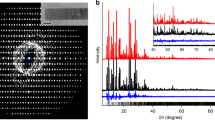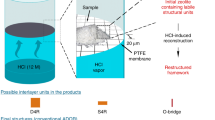Abstract
Precursor nanoparticles that form spontaneously on hydrolysis of tetraethylorthosilicate in aqueous solutions of tetrapropylammonium (TPA) hydroxide evolve to TPA-silicalite-1, a molecular-sieve crystal that serves as a model for the self-assembly of porous inorganic materials in the presence of organic structure-directing agents. The structure and role of these nanoparticles are of practical significance for the fabrication of hierarchically ordered porous materials and molecular-sieve films, but still remain elusive. Here we show experimental findings of nanoparticle and crystal evolution during room-temperature ageing of the aqueous suspensions that suggest growth by aggregation of nanoparticles. A kinetic mechanism suggests that the precursor nanoparticle population is distributed, and that the 5-nm building units contributing most to aggregation only exist as an intermediate small fraction. The proposed oriented-aggregation mechanism should lead to strategies for isolating or enhancing the concentration of crystal-like nanoparticles.
This is a preview of subscription content, access via your institution
Access options
Subscribe to this journal
Receive 12 print issues and online access
$259.00 per year
only $21.58 per issue
Buy this article
- Purchase on Springer Link
- Instant access to full article PDF
Prices may be subject to local taxes which are calculated during checkout






Similar content being viewed by others
References
Corma, A. & Davis, M. E. Issues in the synthesis of crystalline molecular sieves: Towards the crystallization of low framework-density structures. ChemPhysChem 5, 304–313 (2004).
Yang, S., Navrotsky, A., Wesolowski, D. & Pople, J. Study on synthesis of TPA-silicalite-1 from initially clear solutions of various base concentrations by in situ calorimetry, potentiometry, and SAXS. Chem. Mater. 16, 210–219 (2004).
Schoeman, B. & Regev, O. A study of the initial stage in the crystallization of TPA-silicalite-1. Zeolites 17, 447–456 (1996).
Fedeyko, J., Rimer, J., Lobo, R. & Vlachos, D. Spontaneous formation of silica nanoparticles in basic solutions of small tetraalkylammonium cations. J. Phys. Chem. B 108, 12271–12275 (2004).
Mintova, S., Olson, N., Senker, J. & Bein, T. Mechanism of the transformation of silica precursor solutions into Si-MFI zeolite. Angew. Chem. Int. Edn 41, 2558–2561 (2002).
Cheng, C.-H. & Shantz, D. F. Nanoparticle formation and zeolite growth in TEOS/organocation/water solutions. J. Phys. Chem. B 109, 7266–7274 (2005).
de Moor, P. P., Beelen, T. & van Santen, R. In situ observation of nucleation and crystal growth in zeolite synthesis. A small-angle X-ray scattering investigation on Si-TPA-MFI. J. Phys. Chem. B 103, 1639–1650 (1999).
Houssin, C. et al. Combined in situ Si NMR and small-angle X-ray scattering study of precursors in MFI zeolite formation from silicic acid in TPAOH solutions. Phys. Chem. Chem. Phys. 5, 3518–3524 (2003).
Cheng, C. H. & Shantz, D. Silicalite-1 growth from clear solution: effect of the structure-directing agent on growth kinetics. J. Phys. Chem. B 109, 13912–13920 (2005).
Twomey, T. A. M., Mackay, M., Kuipers, H. P. C. E. & Thompson, R. W. In situ observation of silicalite nucleation and growth: A light-scattering study. Zeolites 14, 162–168 (1994).
Choi, J., Ghosh, S., Lai, Z. & Tsapatsis, M. Uniformly a-oriented MFI zeolite films by secondary growth. Angew. Chem. Int. Edn 45, 1154–1158 (2006).
Drews, T. O. & Tsapatsis, M. Progress in manipulating zeolite morphology and related applications. Curr. Opin. Colloid Interface Sci. 10, 233–238 (2005).
Schoeman, B. J. Analysis of the nucleation and growth of TPA-silicalite-1 at elevated temperatures with the emphasis on colloidal stability. Micropor. Mesopor. Mater. 22, 9–22 (1998).
Nikolakis, V., Kokkoli, E., Tirrell, M., Tsapatsis, M. & Vlachos, D. Zeolite growth by addition of subcolloidal particles: modeling and experimental validation. Chem. Mater. 12, 845–853 (2000).
Kirschhock, C. E. A. et al. Zeosil nanoslabs: building blocks in nPr4N+-mediated synthesis of MFI zeolite. Angew. Chem. Int. Edn 40, 2637–2640 (2001).
Corkery, R. W. & Ninham, B. W. Low-temperature synthesis and characterization of a stable colloidal TPA-silicalite-1 suspension. Zeolites 18, 379–386 (1997).
deMoor, P.-P. E. A., Beelen, T. P. M., van Santen, R. A., Beck, L. W. & Davis, M. E. Si-MFI crystallization using a “Dimer” and “Trimer” of TPA studied with small-angle X-ray scattering. J. Phys. Chem. B 104, 7600–7611 (2000).
Glatter, O. The interpretation of real-space information from small-angle scattering experiments. J. Appl. Crystallogr. 12, 166–175 (1979).
Bergmann, A., Fritz, G. & Glatter, O. Solving the generalized indirect Fourier transformation (GIFT) by Boltzmann simplex simulated annealing (BSSA). J. Appl. Crystallogr. 33, 1212–1216 (2000).
Gilbert, B., Huang, F., Zhang, H., Waychunas, G. A. & Banfield, J. F. Nanoparticles: strained and stiff. Science 305, 651–654 (2004).
Gawrys, K. L. & Kilpatrick, P. K. Asphaltenic aggregates are polydisperse oblate cylinders. J. Colloid Interface Sci. 288, 325–334 (2005).
Orthaber, D., Bergmann, A. & Glatter, O. SAXS experiments on absolute scale with Kratky systems using water as a secondary standard. J. Appl. Crystallogr. 33, 218–225 (2000).
Jorge, M., Auerbach, S. M. & Monson, P. A. Modeling spontaneous formation of precursor nanoparticles in clear-solution zeolite synthesis. J. Am. Chem. Soc. 127, 14388–14400 (2005).
Burleson, D. J. & Penn, R. L. Two step growth of goethite from ferrihydrite. Langmuir 22, 402–409 (2006).
Buyanov, R. & Krivoruchko, O. Development of a theory of crystallization of difficultly soluble metal hydroxides and of scientific bases for the preparation of catalysts from substances of this class. Kinetics Catal. 17, 666–675 (1976).
Buyanov, R., Krivoruchko, O. & Ryzhak, I. Mechanism of the nucleation and growth of crystals of iron hydroxide and iron oxide in mother liquors. Kinetics Catal. 13, 470–478 (1972).
Mackenzie, R. C. & Meldau, R. The ageing of sesquioxide gels. I. Iron oxide gels. Mineral Mag. 32, 153–165 (1959).
Navrotsky, A. Energetic clues to pathways to biomineralization: precursors, clusters, and nanoparticles. Proc. Natl Acad. Sci. 101, 12096–12101 (2004).
Penn, R. Kinetics of oriented aggregation. J. Phys. Chem. B 108, 12707–12712 (2004).
Penn, R. L. & Banfield, J. F. Imperfect oriented attachment: dislocation generation in defect-free nanocrystals. Science 281, 969–971 (1998).
Mintova, S., Olson, N. H., Valtchev, V. & Bein, T. Mechanism of zeolite a nanocrystal growth from colloids at room temperature. Science 283, 958–960 (1999).
Mintova, S., Olson, N. H. & Bein, T. Electron microscopy reveals the nucleation mechanism of zeolite Y from precursor colloids. Angew. Chem. Int. Edn 38, 3201–3204 (1999).
Bonilla, G. et al. Zeolite (MFI) crystal morphology control using organic structure-directing agents. Chem. Mater. 16, 5697–5705 (2004).
Wollast, R. & Garrels, R. Diffusion coefficient of silica in seawater. Nature 229, 94 (1971).
Corma, A. & Diaz-Cabanas, M. J. Amorphous microporous molecular sieves with different pore dimensions and topologies: synthesis, characterization, and catalytic activity. Micropor. Mesopor. Mater. 89, 39–46 (2006).
Rimer, J., Vlachos, D. & Lobo, R. Evolution of self-assembled silica-tetrapropylammonium nanoparticles at elevated temperatures. J. Phys. Chem. B 109, 12762–12771 (2005).
Van Hyning, D. L., Klemperer, W. G. & Zukoski, C. F. Silver nanoparticle formation: Predictions and verification of the aggregative growth model. Langmuir 17, 3128–3135 (2001).
Glatter, O. A new method for the evaluation of small-angle scattering data. J. Appl. Crystallogr. 10, 415–421 (1977).
NIST SANS Data Reduction. <http://www.ncnr.nist.gov/programs/sans/data/data_red.html>.
Talmon, Y. in In Modern Characterization Methods of Surfactant Systems (ed. Binks, B. P.) (Marcel Dekker, New York, 1999).
Nagahara, L. A., Hashimoto, K., Fujishima, A., Snowden-Ifft, D. & Price, P. B. Mica etch pits as a height calibration source for atomic force microscopy. J. Vac. Sci. Technol. B 12, 1694–1697 (1994).
Ulman, A. et al. Concentration-driven surface transition in the wetting of mixed alkanethiol monolayers on gold. J. Am. Chem. Soc. 113, 1499–1506 (1991).
Evans, S. D., Sharma, R. & Ulman, A. Contact angle stability: reorganization of monolayer surfaces? Langmuir 7, 156–161 (1991).
Acknowledgements
Financial support for this work was provided by NSF (NIRT CTS-0103010 and CTS-05 22518). The HRTEM work was supported in part by NSF-MRI EAR-0320641 and the MRSEC Program of NSF under Award Number DMR-0212302. M.K. acknowledges support from NSF (DMS-041386). Characterization was carried out at the Minnesota Characterization Facility, which receives support from NSF through the National Nanotechnology Infrastructure Network. Numerical simulations were carried out using the facilities of the Supercomputing Institute for Digital Simulation and Advanced Computation at the University of Minnesota. We thank A. Parr for lending us the SAXSess instrument; F. S. Bates for providing access to SANS analysis at NIST and for helpful discussions; and R. Bedard, D. G. Vlachos, V. Nikolakis, R. F. Lobo and V. Hatzimanikatis for input at various stages of this work.
Author information
Authors and Affiliations
Corresponding author
Ethics declarations
Competing interests
The authors declare no competing financial interests.
Supplementary information
Supplementary Information
Supplementary figures S1 - S9 (PDF 7591 kb)
Rights and permissions
About this article
Cite this article
Davis, T., Drews, T., Ramanan, H. et al. Mechanistic principles of nanoparticle evolution to zeolite crystals. Nature Mater 5, 400–408 (2006). https://doi.org/10.1038/nmat1636
Received:
Accepted:
Published:
Issue Date:
DOI: https://doi.org/10.1038/nmat1636
This article is cited by
-
Non-classical crystallization in soft and organic materials
Nature Reviews Materials (2024)
-
Crystal dissolution by particle detachment
Nature Communications (2023)
-
Synthesis strategies and design principles for nanosized and hierarchical zeolites
Nature Synthesis (2022)
-
Dominance of heat transfer limitations in conventional sol-gel synthesis of LTA revealed by microcrystallization
Journal of Flow Chemistry (2022)
-
Seed-induced synthesis of functional MFI zeolite materials: Method development, crystallization mechanisms, and catalytic properties
Frontiers of Chemical Science and Engineering (2020)



